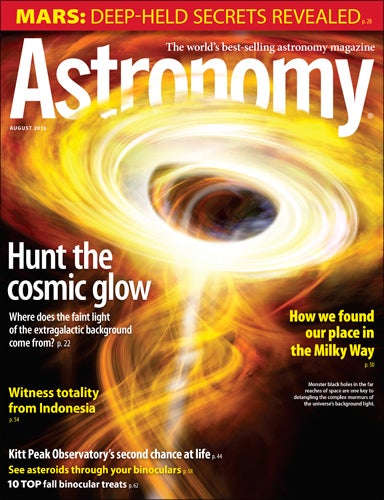Video FAQ page
In “Searching for the universe’s background glow,” Contributing Editor Liz Kruesi guides you through the many ways astronomers hunt the EBL and uncover where the various wavelengths come from. Some of these techniques directly count light from galaxies, while others use indirect methods, such as measuring the light that doesn’t make it to sensitive telescopes. Kruesi explores both the history of the EBL’s discovery and the work still ongoing with telescopes around the world and beyond in space.
To learn more about what’s causing the EBL’s cosmic glow, pick up the August 2015 issue of Astronomy magazine, on newsstands July 7.
“A fresh look at Mars”
Planetary scientist Jim Bell reviews the armada of spacecraft exploring the Red Planet and their latest and most exciting discoveries in “A fresh look at Mars.” The fleet currently includes two active rovers and five orbiting satellites from the American, European, and Indian space programs. They map the planet’s surface, perform geologic and atmospheric studies, and dig ever deeper into the potential for habitability, both past and present.
“Kitt Peak Observatory’s new lease on life”
As the world of research astronomy moves farther away from directed individual projects and toward larger and usually automated surveys, it leaves less time and funding for small groups — or small telescopes, even those considered large and cutting edge only a few decades ago. In “Kitt Peak Observatory’s new lease on life,” Associate Editor Eric Betz reports on how observatories — Kitt Peak in Arizona and others — are adapting to the changing times and technologies.
“Finding our place in the Milky Way”
Humankind longs to understand its place in the cosmos. Determining our position is a task that stretches back to Aristarchus in the third century B.C. and is still ongoing today as we struggle to map the galaxy we inhabit. How did we come to understand the distances to the stars, the shape of the Milky Way, and our place in it? Alan Goldstein retraces the steps to discovering these answers in “Finding our place in the Milky Way.”
August sky events visible without optical aid
- August 13 — The Perseid meteor shower peaks under Moon-free skies.
- August 29 — Venus and Mars share the eastern predawn sky.
Also in the August 2015 Astronomy
- “Witness totality from Indonesia”: On March 9, 2016, a total solar eclipse will cast Indonesia into midday darkness, and Astronomy will be there to share the sights and delights of nearby Bali.
- “Target asteroids with your binoculars”: Despite their small size, many asteroids appear clearly through binoculars. Learn more about these minor planets and how to spot them even with small optics.
- “Tour 10 fall binocular treats”: Star clusters, asterisms, and even a spiral galaxy make this list of great visual treats for those with binoculars, dark skies, and a love of the heavens.
- “Astronomy test Daystar’s Quark”: This small Hydrogen-alpha filter inserts as easily as an eyepiece and gives spectacular views of solar prominences and activity in the Sun’s atmosphere.
- “The Sky this Month”: Exclusive star charts will guide you through August’s night sky.
- The August issue also features Snapshot, Breakthrough, Astro News, Ask Astro, Bob Berman’s Strange Universe, Jeff Hester’s For Your Consideration, Glenn Chaple’s Observing Basics, Stephen James O’Meara’s Secret Sky, Adam Block’s Cosmic Imaging, New Products, Letters, Web Talk, and Reader Gallery.
Astronomy offers you the most exciting, visually stunning, thorough, and timely coverage of the heavens above. Each monthly issue includes expert science reporting, vivid color photography, complete sky-event coverage, spot-on observing tips, informative equipment reviews, and more. All of this comes in an easy-to-understand user-friendly style that’s perfect for astronomers at any level. Contact Astronomy, the world’s best-selling astronomy magazine, at 262.796.8776 or email editor@astronomy.com.










